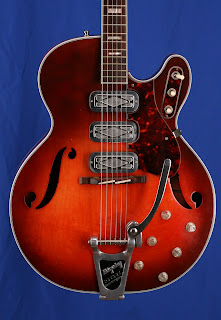Introduced in 1962, the Jaguar was Fender's top of the line model throughout the 60's. Historically that seems hard to believe, as the Jag is a short scale guitar, but it was significantly more expensive than any other Fender guitar of the era. The Jaguar and took its offset body shape from the Jazzmaster, and added some stylistic differences, including chrome control plates and a bass cut switch. Sales were brisk for through 1966, when the production numbers began to tail off as the guitar's twangy tones were becoming passe in the burgeoning psychedelic scene. The Jaguar was eventually dropped from the lineup in 1975, and was resurrected as a reissue by Fender Japan in the 80's, only to see a massive revival in the hands of Kurt Cobain in the early '90's.
For many, though, the Jaguar is the ultimate surf guitar, and was also
seen in the hands of brilliant soul singer/ guitarist Barbara Lynn.
notice the lovely Brazilian rosewood fingerboard
closeup of Fender's 'clay dot' inlays; nobody has ever been able to properly duplicate them!
images c2012 Derek See; guitar courtesy of James Williamson.
notice the lovely Brazilian rosewood fingerboard
closeup of Fender's 'clay dot' inlays; nobody has ever been able to properly duplicate them!
images c2012 Derek See; guitar courtesy of James Williamson.





















































